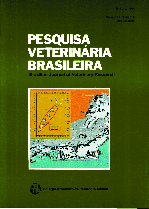 |
|
|
|
Year 2002 - Volume 22, Number 4
|

|
Genetic and antigenic analysis of Babesia bigemina isolates from five geographical regions of Brazil, 22(4):153-160
|
ABSTRACT.- Madruga C.R., Leal C.R.B., Ferreira A.M.T., Araújo F.R., Bonato A.L.V., Kessler R.H., Schenk M.A.M. & Soares C.O. 2002. Genetic and antigenic analysis of Babesia bigemina isolates from five geographical regions of Brazil. Pesquisa Veterinária Brasileira 22(4):153- 160. [Análise genética e antigênica de isolados de Babesia bigemina das cinco regiões fisiográficas do Brasil.] Embrapa Gado de Corte, Rodovia BR 262 Km 4, Cx. Postal 154, Campo Grande, MS 79002-970, Brazil.
A molecular epidemiological study was performed with Babesia bigemina isolates from five geographical regions of Brazil. The genetic analysis was done with random amplification of polymorphic DNA (RAPD), repetitive extragenic palindromic elements-polymerase chain reaction (REP-PCR) and enterobacterial repetitive intergenic consensus sequences-polymerase chain reaction (ERIC-PCR) that showed genetic polymorphism between these isolates and generated fingerprinting. In RAPD, IL0872 and IL0876 primers were able to detect at least one fingerprinting for each B. bigemina isolate. The amplification of B. bigemina DNA fragments by REP-PCR and ERIC-PCR gave evidence for the presence in this haemoprotozoan of the sequences described previously in microorganisms of the bacterial kingdom. For the first time it was demonstrated that both techniques can be used for genetic analysis of a protozoan parasite, although the ERIC-PCR was more discriminatory than REP-PCR. Toe dendogram with similarity coeficiente among isolates showed two clusters and one subcluster. The Northeastern and Mid-Westem isolates showed the greatest genetic diversity, while the Southeastem and Southem isolates were the closest. Toe antigenic analysis was done through indirect fluorescent antibodytechnique and Westem blotting using a panei of monoclonal antibodies directed against epitopes on the merozoite membrane surface, rhoptries and membrane of infected erythrocytes. As expected, the merozoite variable surface antigens, major surface antigen (MSA)-1 and MSA-2 showed antigenic diversity. However, B cell epitopes on rhoptries and infected erythrocytes were conserved among all isolates studied. In this study it was possible to identify variable and conserved antigens, which had already been described as potential immunogens. Considering that an attenuated Babesia clone used as immunogen selected populations capable of evading the immunity induced by this vaccine, it is necessary to evaluate more deeply the cross-protection conferred by genetically more distant Brazilian B. bigemina isolates and make an evaluation of the polymorphism degree of variable antigens such as MSA-1 and MSA-2. |
| |
|
|
| |
|
 |